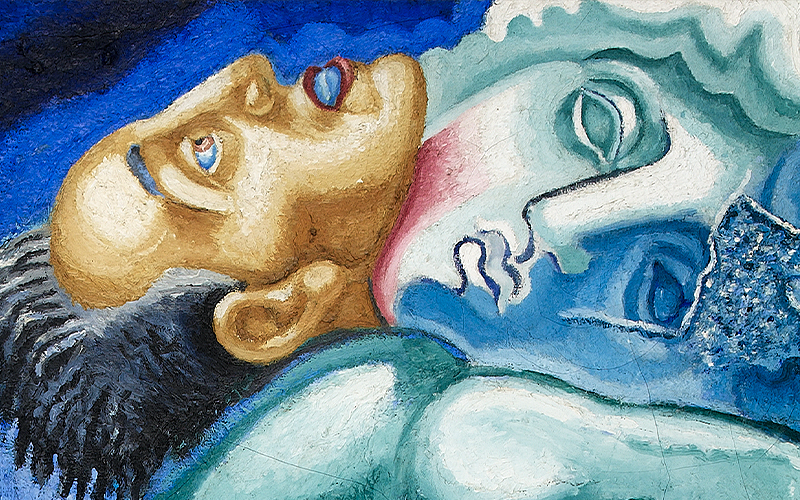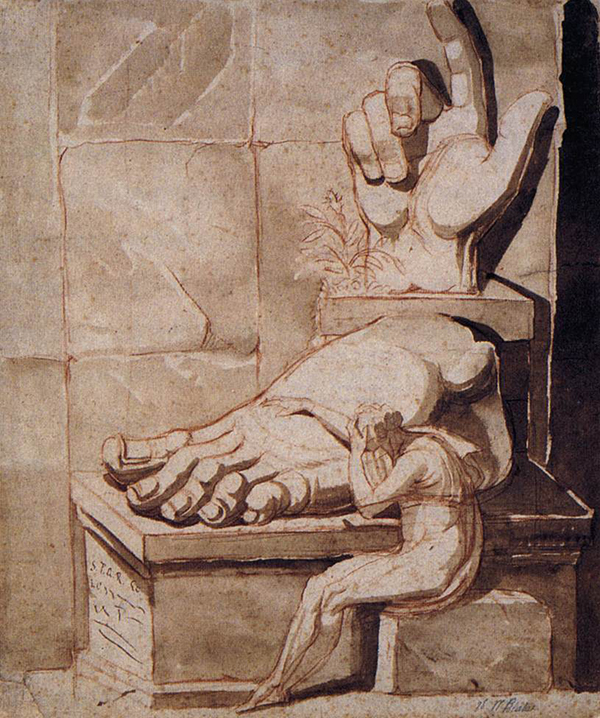‘Fuga’ [Escape]

I seek the synthesis of form. With each brushstroke, I’m looking for a cerebral intention. That’s why I’d like to have paintbrushes on my head instead of hair when I paint. That would be a more direct way of making the painting the way I want it, because between the head and the hands there are many betrayals to corrupt an obedient rendering.
Mário Eloy in the catalogue for the 1st Independents Salon, Lisbon, 1930
Mário Eloy produced this painting over the course of five months, in the studio of his close friend Jorge Segurado. His reference to the time it took to complete the work, in the correspondence exchanged with Segurado about the selection of his pieces for the SPN’s IV Exhibition of Modern Art (in 1939), emphasises how important this painting was to Eloy: ‘The exhibition only interests me if it includes ‘Fuga’ […];’ or, in another letter, ‘[…] I’m extremely sorry to have to tell you that, if ‘Fuga’ is not shown, I won’t take part in the Salon. […] I spent five months on this painting, something stayed there in it, let it go through.’
In truth, a great deal stayed on this canvas that hits us like a brutal declaration. What do we see?

At first glance, a man seems to be running. We feel the force that oppresses him in the compact depiction of his torso, the waist striving to control the legs and feet, which bend and cross in a rather unruly fashion. No one runs like that. The head is thrown back, forming an impossible right angle with the shoulders. The eyes are fixed, glassy, the mouth open in a grimace.
His right arm supports, rather than encircles, the large white head he is carrying, cracked on the face and clearly broken above the left eye. The Apollonian proportions between the outline of the nose and the symmetrical placing of the eyes, mouth and hair suggest that it is a fragment of a classical sculpture. A patch of colour spreads between this head and the man’s stretched neck, a red abrasion whose tone is echoed in the five roses dangling from a tousled and broken bunch held in his left hand. This hand also firmly clutches the right arm from underneath, the four visible fingers strong and well-defined.
Below the waist, the horizontal line of the thigh is not sufficient to stabilise the tense angles formed by the bent legs, as if gathering momentum to jump. And, standing out from this amalgam of legs and trousers, isolated, vibrant, and perfectly illuminated in the foreground, the left foot, its sole facing us. A vertically drawn foot flung in the air, the thick, round heel, the delineated phalanges of the toes, the big toe slightly apart in a spasmodic twist.
The red is merely a dual note on a canvas that reverberates with the thick layers of greens, blues and ochres characteristic of Eloy’s painting. The man depicted – perhaps a self-portrait, prematurely aged – might be described as a sculpture brought to life but caught in strong impasto waves of paint. Textured colour is a fundamental aspect of this artist’s painting, whose frequently dark palette tends, in this canvas, towards the rich modulations of ultramarine and viridian, his favourite colours.
In her analysis of Füssli’s drawing The Artist Overwhelmed by the Grandeur of Antique Ruins1, from 1778–79, Linda Nochlin describes the depiction of the fragment as a metaphor for modernity, the construction of the Modern as the result of the tragic loss of totality, of unity.2

This painting by Eloy strikes me as a modernist take on the awareness of that conflict, that loss (which was also personal, partly due to the devastating Huntington’s disease from which he already suffered and which would be diagnosed the following year). In terms of his paintings exhibited in Berlin ten years earlier, and despite declaring himself an expressionist and great admirer of Kokoschka, Eloy stated that it was ‘cubism from which I build the profoundly classical figures I paint today – because cubism, in its essence, is classical – seeking to have conscious feeling alongside abstract emotion.’
This understanding of the fragmented role of the classical in modernity is represented in Fuga, and Jorge Segurado sensed this when he commented that it was an ‘extremely modern work [with] a burst of classicism.’ Profoundly anti-academic and anti-bourgeois in the sense of the disquiet and discomfort he sought, Eloy’s artistic commitment was towards his true inner self, the absolute need for creation as the only relationship possible with the work and with himself.
I recommend looking up the catalogue for the retrospective exhibition held by the Museu do Chiado in 1996, as well as Lígia Afonso’s study, published in 2010 by QuidNovi as part of their collection on Portuguese painters.
Ana Vasconcelos
Curator of the CAM
1 The Artist Overwhelmed by the Grandeur of Antique Ruins
2 The Body in Pieces. The Fragment as Metaphor of Modernity, UK, Thames & Hudson, 1994
Curators’ Choices
The curators of the CAM reflect on a selection of works, which include creations by national and international artists.
More choices